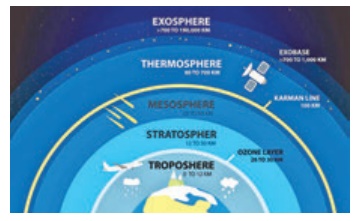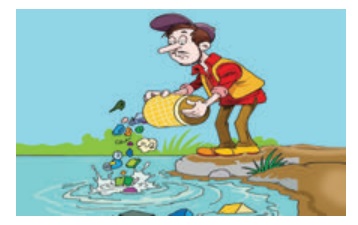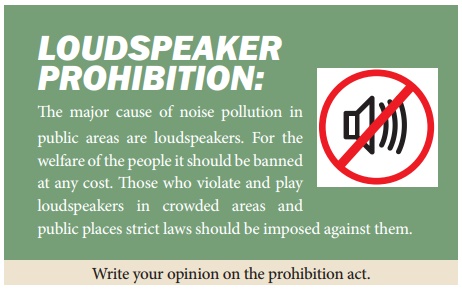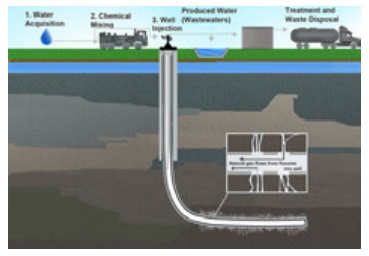Chapter: 9th Social Science : Geography: Man and Environment
Environmental Issues
Environmental Issues
Environment is the basic life support system that provides air, water, food and land to all living organisms. But human beings degrade the environment through rapid industrialization.
Human life will be at risk if they don’t live in harmony with the environment. Environmental problems are not limited to the local, regional and national level, but there are several global issues. Scientific and technological revolutions has given a lot of facilities to mankind, but at the same time it is responsible for the depletion of resources. Thus, several environmental problems have emerged. Some of the environmental issues that we are going to learn are:
· Deforestation
· Pollution such as air, water ,noise, etc
· Urbanisation
· Fracking
· Waste disposal
1. Deforestation
Deforestation is the cutting down of trees permanently by the people to clear forests in order to make the land available for other uses.
Effects of Deforestation:
Deforestation results in many effects like floods and droughts, loss of soil fertility, air pollution, extinction of species, global warming, spread of deserts, depletion of water resource, melting of ice caps and glaciers, rise in sea level and depletion of ozone layer.
The United Nations Conference on Environment and Development (UNCED) by name Earth Summit Conference held at Rio de Janeiro, Brazil, on June 1992 concluded that all member countries should reduce their emission of carbon dioxide, methane and other green house gases thought to be responsible for global warming.
Conservation of forests
(i) Conservation of forests can be done through the regulation of cutting of trees.
(ii) Control over forest fire: Through regular monitoring and controlling the movement of the people forest fire can be prevented.
(iii) Reforestation and afforestation: Reforestation involves the replanting or regeneration of areas of forest which have previously been damaged or destroyed. Sometimes forests are able to regenerate naturally. Afforestation is the process of planting trees or sowing seeds on barren land devoid of any trees to create a forest.
The term afforestation should not be confused with reforestation, which is the pr1ocess of specifically planting native trees into a forest that has decreasing number of trees. While reforestation is increasing the number of trees of an existing forest, afforestation is the creation of a new forest.
(iv) Proper use of forest products: We depend on forests for our survival from the air we breathe, to the wood we use. Besides providing habitats for animals and livelihoods for humans, forest products are one of the most essential things in our day to day life. Therefore we must use forest products properly.![]()
(v) Sustainable forest management: The use of forest and forest lands in a way and at a rate, that maintains their biodiversity, productivity, regeneration capacity, vitality and their potential to fulfill the global levels should not cause damage to other eco systems.
Forest Management seeks to achieve a balance between the society's increasing demands for forest products, its benefits and the preservation of forest health and diversity too. This balance is critical to the survival of forests and to the prosperity of forest dependent communities.
2. Pollution
Environmental pollution occurs when pollutants contaminate the natural surroundings. Pollution disturbs the balance of our eco system affecting our normal life styles and gives rise to human illnesses and global warming. The word ‘pollute’ means to degrade or to make dirty. Pollution is thus, an unfavourable modification of the natural world, caused entirely or partly due to direct or indirect actions of human beings.
There are many types of pollution degrading the environment. They are
a. Air pollution
b. Water pollution
c. Land pollution
d. Noise pollution
e. Light pollution
A. Air pollution
Due to some human activities or natural processes, the amount of solid wastes or concentration of gases, other than oxygen increases in air. Air thus becomes polluted and this process is called air pollution.
The pollutants are generally grouped as natural and manmade. The natural pollutants are volcanic eruptions, wind erosion, pollen disposal, evaporation of organic compounds and radioactive elements etc., Natural air pollution does not occur in abundance and also creates a little impact on the environment.
But, manmade pollutants like vehicular emission, industrial wastes, smoke from thermal power plants and refineries badly affect the environment. The main pathological effects caused by air pollutants, particularly oxides of sulphur, nitrogen and carbon-di- oxide, include respiratory disorders, jaundice, irritation of eyes and throat, headache, cancer and even death.
Green house effect
Global warming is caused by the increase of green house gases such as carbondioxide, methane, water vapour and Chloro Fluoro Carbons(CFC), carbon monoxide, photo chemical oxidants and hydrocarbons, which are responsible for the heat retention ability of the atmosphere. Global warming causes climatic change, ozone layer depletion, rise in sea level and drowning of coastal inhabited land, melting of ice, etc., They are posing an even greater threat to human existence and so, man must start thinking of protecting the environment from pollution.
Acid Rain
When pollutants combine with water vapour in the presence of sunlight and oxygen, they form dilute sulphuric and nitric acids in the atmosphere. When this mixture precipitates from the atmosphere, it is called acid rain. The gases that cause acid rain are sulphur-di-oxide, nitrogen oxides, carbon- di-oxide and other minute bio-products, caused by the burning of fossil fuels.
Ozone Depletion
Ozone layer is depleted by the pollutants like CFCs, HFCs, methyle bromite, etc. Due to the depletion of ozone layer, UV rays fall on the earth's surface, warming the earth surface and leads to impervious diseases like skin cancer, blindness, loss of plankton etc.,

Ozone layer
Ozone is a poisonous gas made up of molecules consisting of three oxygen atoms (O3). This gas is extremely rare in the atmosphere, representing just three out of every 10 million molecules.
The ozone layer is not really a layer at all, but has become known as such because most ozone particles are scattered between 19 and 30 kilometre up in the earth's atmosphere, in a region called the stratosphere.
Ozone layer in the atmosphere absorbs most of the harmful ultraviolet radiation from the sun. It also screens out the deadly UV-C radiation the ozone shield is this essential to protect life.

B. Water Pollution
Water pollution is any chemical, physical or biological change in the quality of water that has a harmful effect on any living thing that drinks or uses or lives in it. The water bodies including ponds, lakes, rivers, ground water and oceans are contaminated by the chemical wastes from industries, domestic wastes and sewage etc.
Major water pollutants
a) The disease – Causing agents; bacteria, viruses, protozoa and parasitic worms that enter sewage – systems and untreated waste.
b) Oxygen demanding bacteria: Wastes that can be decomposed by oxygen requiring bacteria.
c) Water soluble inorganic pollutants: Acids, Salt and toxic metals.
d) Organic compounds: Oil, plastics and pesticides in the water.
Our role in conserving water;
1. Do not dump in or around rivers. Clean up rivers that have a lot of trash in and around them.
2. Never dispose of cooking fats and oils by pouring them down the sink.
3. In the bathroom, take short showers and draw less water for baths. When you buy a new toilet, purchase a low flow model (1.6 gallons or less per flush). Check your toilet for "silent" leaks by placing a little food coloring in the tank and see if it leaks into the bowl.
4. Turn off water while brushing teeth, washing, gardening and shaving.
5. Keep a gallon of drinking water in the refrigerator, rather than running the tap for cold water. Run your washing machine with a full load of clothes. Wash with warm water instead of hot water, rinse with cold water instead of warm water.

Causes of Water Pollution
Main pathological problems caused due to water pollution include diarrhoea, liver cirrhosis, lung cancer, kidney diseases, paralysis, chronic pain, bone deformities, cancer and even death and so on.
C. Land Pollution
Land pollution is contaminating the land surface of the earth through dumping of urban waste matter. It arises from the breakage of underground storage tanks, application of pesticides and percolation of contaminated surface water, oil and fuel dumping, leaching of wastes from landfills or direct discharge of industrial wastes to the soil.
Preventive Measures
1. Things used for domestic purposes can be reused and recycled.
2. Organic waste matter should be disposed off far away from the settlements.
3. Inorganic wastes can be separated, reclaimed and recycled.
D. Noise Pollution
Noise pollution is basically a problem of urban areas, industrial areas, transport areas due to bombardment, traffic etc. It has an impact on the habitat of animals migration and health of inhabitants. E.g. Chandipur Missile Launching Centre has created migration of sea birds. Hearing loss, hypertension, stress and mental illness are the major health hazards that human beings face.
The control measures of noise pollution
1. Development of green belt vegetation.
2. Installation of decibel meters along highways and in places of public gatherings.
3. Planting trees along the compound wall to protect houses. resources, wildlife, humans and astronomy research.

E. Light pollution
Light pollution is an unwanted consequence of outdoor lighting and includes such effects as sky glow, light trespass and glare. It is caused by streetlights, parking lot lights, floodlights, signs, sports field lighting decorative and landscape lights. It affects the environment, energy resources, wildlife, humans and astronomy research.
3. Urbanisation
Urbanisation refers to the process of increase in urban population and urban areas in a country.
Problems of urbanisation
As the town expands, it mounts more pressure on transport system, water supplies, sewage and profuse disposal. The overall development creates problems like air pollution, water pollution, traffic congestion and noise pollution etc., This disturbed environment affects the human beings as mental illness, heart troubles, breathing problems etc.

4. Fracking
The modern technology applied to extract oil and gas while fracturing the rocks artificially with the use of pressurized liquid is called fracking. Fracking fluid is a mixture of water, sand and thickening agents. The first successful implementation of the process was done in 1950.
Methane is one of the most important chemicals used in fracking process. It is estimated that four percent of methane escapes into the atmosphere during extraction.
Methane is 25 times stronger than carbon di- oxide in terms of trapping heat. The spills of this gas is detrimental to the air quality of the surrounding fracking sites. Pollutants decrease the availability of clean air for workers and local residents.

Other Environmental Concerns
Fracking not only pollutes water and air but also pollutes the soil. The oil spills during fracking can harm the soil and the surrounding vegetation. The use of high pressure at the time of oil extraction and the storage of waste water on site may cause earthquakes.
5. Waste disposal
Things become waste when their purpose of consumption is over. Wastes can be classified into five types, which are commonly found around the house. These include liquid waste, solid rubbish, organic waste, recyclable rubbish and hazardous waste like e-waste.
How to dispose of waste :
· Do not litter your surroundings. Use a proper waste bin to store your wastes.
· People should practise to segregate degradable and non-degradable wastes and should dispose them in proper coloured bins. Wastage is generally classified into three types. They are
![]() Wet Waste: which comes from the kitchen/ cooking/food, etc.
Wet Waste: which comes from the kitchen/ cooking/food, etc.
![]() Dry Recyclable Waste: such as newspapers, cardboard, packing plastics, bottles, cans, etc., should go to a different bin.
Dry Recyclable Waste: such as newspapers, cardboard, packing plastics, bottles, cans, etc., should go to a different bin.
![]() Rejected Waste: which does not belong to the above two categories, including bio waste like diapers and bandages, etc..
Rejected Waste: which does not belong to the above two categories, including bio waste like diapers and bandages, etc..
Sewage sludge is produced by waste water treatment processes. Due to rapid urbanization, there has been an increase in municipal waste water. Common disposal practices of sewage should be send to sewage treatment plant through proper drainage pipes.
Electronic Waste (e-waste): It can be defined as any electrical goods, devices or components that you no longer want or have already thrown away. For example, computers, televisions, mobiles and fax machines.
This waste can take many years to break down, if at all and can contain toxic chemicals such as mercury, lead and lithium that leach into the ground and cause illness. Even short- term exposure to high levels of lead can result in vomiting and diarrhea. Instead of sending e-waste to the dump, components from electronics can be reused to make new products.
Related Topics